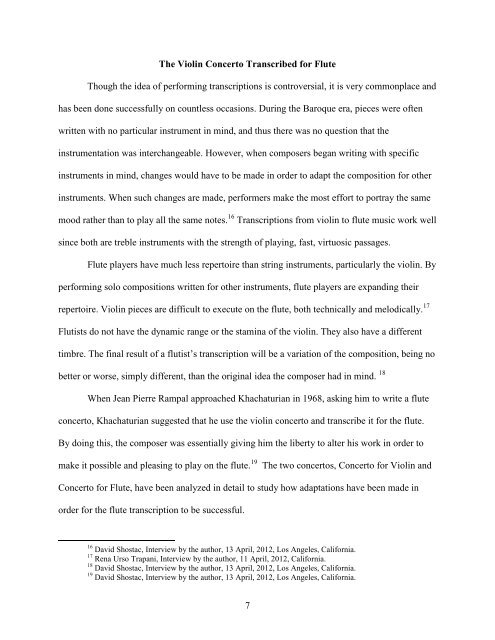a performance analysis of the khachaturian flute concerto - CSUN ...
a performance analysis of the khachaturian flute concerto - CSUN ...
a performance analysis of the khachaturian flute concerto - CSUN ...
You also want an ePaper? Increase the reach of your titles
YUMPU automatically turns print PDFs into web optimized ePapers that Google loves.
The Violin Concerto Transcribed for Flute<br />
Though <strong>the</strong> idea <strong>of</strong> performing transcriptions is controversial, it is very commonplace and<br />
has been done successfully on countless occasions. During <strong>the</strong> Baroque era, pieces were <strong>of</strong>ten<br />
written with no particular instrument in mind, and thus <strong>the</strong>re was no question that <strong>the</strong><br />
instrumentation was interchangeable. However, when composers began writing with specific<br />
instruments in mind, changes would have to be made in order to adapt <strong>the</strong> composition for o<strong>the</strong>r<br />
instruments. When such changes are made, performers make <strong>the</strong> most effort to portray <strong>the</strong> same<br />
mood ra<strong>the</strong>r than to play all <strong>the</strong> same notes. 16 Transcriptions from violin to <strong>flute</strong> music work well<br />
since both are treble instruments with <strong>the</strong> strength <strong>of</strong> playing, fast, virtuosic passages.<br />
Flute players have much less repertoire than string instruments, particularly <strong>the</strong> violin. By<br />
performing solo compositions written for o<strong>the</strong>r instruments, <strong>flute</strong> players are expanding <strong>the</strong>ir<br />
repertoire. Violin pieces are difficult to execute on <strong>the</strong> <strong>flute</strong>, both technically and melodically. 17<br />
Flutists do not have <strong>the</strong> dynamic range or <strong>the</strong> stamina <strong>of</strong> <strong>the</strong> violin. They also have a different<br />
timbre. The final result <strong>of</strong> a flutist’s transcription will be a variation <strong>of</strong> <strong>the</strong> composition, being no<br />
better or worse, simply different, than <strong>the</strong> original idea <strong>the</strong> composer had in mind. 18<br />
When Jean Pierre Rampal approached Khachaturian in 1968, asking him to write a <strong>flute</strong><br />
<strong>concerto</strong>, Khachaturian suggested that he use <strong>the</strong> violin <strong>concerto</strong> and transcribe it for <strong>the</strong> <strong>flute</strong>.<br />
By doing this, <strong>the</strong> composer was essentially giving him <strong>the</strong> liberty to alter his work in order to<br />
make it possible and pleasing to play on <strong>the</strong> <strong>flute</strong>. 19 The two <strong>concerto</strong>s, Concerto for Violin and<br />
Concerto for Flute, have been analyzed in detail to study how adaptations have been made in<br />
order for <strong>the</strong> <strong>flute</strong> transcription to be successful.<br />
16 David Shostac, Interview by <strong>the</strong> author, 13 April, 2012, Los Angeles, California.<br />
17 Rena Urso Trapani, Interview by <strong>the</strong> author, 11 April, 2012, California.<br />
18 David Shostac, Interview by <strong>the</strong> author, 13 April, 2012, Los Angeles, California.<br />
19 David Shostac, Interview by <strong>the</strong> author, 13 April, 2012, Los Angeles, California.<br />
7













